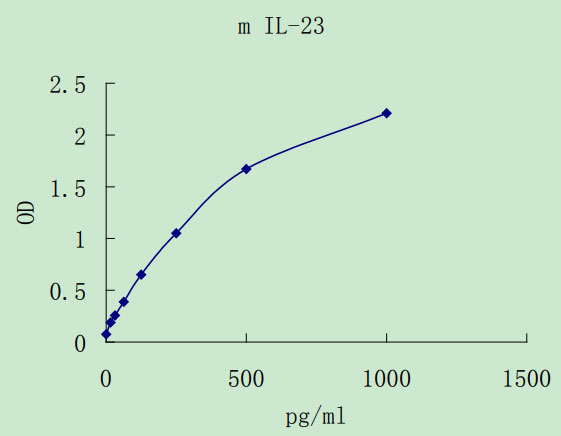Interleukin 23 (IL-23) is a heterodimeric cytokine that is related to IL-12 (1-3). It is composed of two disulfide-linked subunits, a 19 kDa (p19) subunit that is unique to IL-23, and a 40 kDa (p40, IL-12) subunit that is shared with IL-12 (3-7). Mature mouse p19 and p40 share 88% and 92% aa sequence identity, respectively, with the corresponding rat subunits. IL-23 is produced by activated macrophages, microglia, and monocyte-derived dendritic cells in response to pathogens including certain bacteria and viruses and/or their components (3, 6). The functional IL-23 receptor complex consists of two receptor subunits, the IL-12 receptor-1 subunit (IL-12 Rβ1) and the IL-23-specific receptor subunit (IL-23 R) (7). IL-23 and IL-12 have overlapping and distinct biological activities. The IL-23 immune pathway induces the earliest recruitment of neutrophils to the site of infection, while the more classic host defense and cytotoxic response is stimulated by IL-12 (4). IL-23 has a role in the development and maintenance of a T cell subset, designated Th17, that is characterized by the production of IL-17A, IL-17F, IL-6, and TNF-α(3, 4, 8). The IL-23/IL-17 axis is an important mediator of inflammation. In mouse models, transgenic over-expression of IL-23 leads to a lethal systemic infl ammatory response (9). IL-23 eff ects on Th17 cells may also enhance the development of several models of autoimmune disease including experimental allergic encephalomyelitis (EAE), collagen-induced arthritis (CIA), colitis, and diabetes (5, 8, 10-14). IL-23 may also play a role in increased tumor growth associated with chronic inflammation (15).
Hunter, C.A. (2005) Nat. Rev. Immunol. 5:521.
Langrish, C.L. et al. (2006) Immunol. Rev. 202:96.
McKenzie, B.S. et al. (2006) Trends Immunol 27:17.
Aggarwal, S. et al. (2003) J. Biol. Chem. 278:1910.
Cua, D.J. et al. (2003) Nature 421:744.
Oppmann, B. et al. (2000) Immunity 13:715.
Parham, C. et al. (2002) J. Immunol. 168:5699.
Langrish, C.L. et al. (2005) J. Exp. Med. 201:233.
Wiekowski, M.T.et al. (2001) J. Immunol. 166:7563.
Nakae, S. et al. (2003) J. Immunol. 171:6173.
Nakae, S. et al. (2003) Proc. Natl. Acad. Sci. USA 100:5986.
Mensah-Brown, E.P. et al. (2006) Eur. J. Immunol. 36:216.
Yen, D. et al.(2006) J. Clin. Invest. 116:1310.
Chen, Y. et al. (2006) J. Clin. Invest. 116:1317.
Langowski, J.L. et al. (2006) Nature 442:461.

